Creating iOS development environment is a straightforward process if you meet the requirements. In order to have an iOS development environment, you need to:
- Have a Mac machine that runs OS X Mountain Lion (10.8) or higher versions
- Install Xcode on your Mac machine
- Install the iOS SDK on your Mac machine
Xcode is the official Apple IDE that allows you to develop applications for Mac, iPhone, and iPad. Xcode has a lot of great features, some of which are:
- Source code editor
- Assistant editor
- User-interface builder
- iOS simulator
- Static code analyzer
- A powerful built-in open source low-level virtual machine (LLVM) compiler for C, C++, and Objective-C
- The Live Issues feature, which highlights the common coding mistakes while coding your application, without the need to build your project
- Complete support for SCM systems (subversion and Git source control)
You can download the latest version of Xcode from the Apple App Store on your Mac machine. You will find the iOS SDK included with Xcode, so there is no need to download anything other than Xcode.
In order to download the latest version of Xcode, follow these steps:
- Open the App Store application on your Mac machine.
- In the search field of App Store, type in
Xcodeand press enter. - Download Xcode, and after completing the download, you will find it under your
applicationsdirectory. The following screenshot shows the Xcode icon: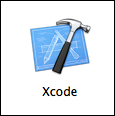
The Xcode icon
If you have an earlier version of OS X (less than 10.8), you need to upgrade it. In order to download Xcode, you need OS X Version 10.8 (or higher).
Now, it is time to make our Sound Recorder application support iPad and iPhone devices. The following command adds iOS platform support for our Sound Recorder application:
> cordova platform add ios
Then, build our application in the iOS platform using the following Cordova build command:
> cordova build ios
Open your Xcode environment, click on Open other, and then select the SoundRecorder.xcodeproj file under the platforms/ios directory to open our Sound Recorder iOS project.
You will find our Sound Recorder application open in Xcode. In order to run our project on an iPhone (or iPad) emulator, click on the Build and run button after selecting the iPhone emulator, as shown in the following screenshot:
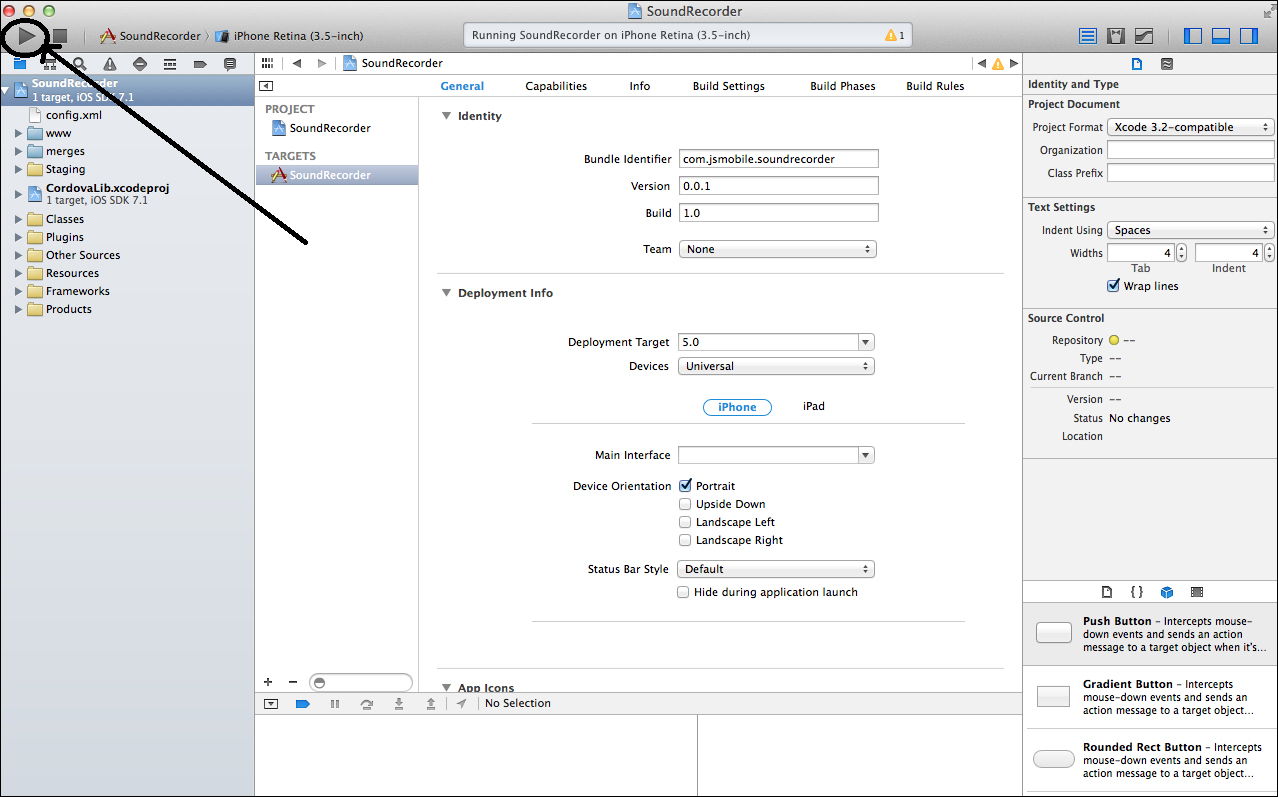
Running the Sound Recorder application in Xcode
After clicking on the Build and run button, the iPhone emulator will be launched with our Sound Recorder application and you can start using it.
An important point that you have to be aware of is that if you are deploying your application on iOS 7, and because of a bug in Apache Cordova 3.4, you will find an overlay between your application and the device status bar, as shown in the following screenshot:
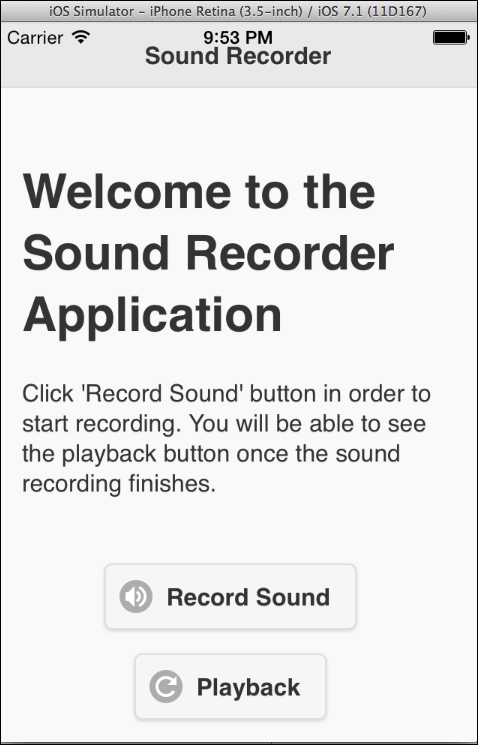
Apache Cordova 3.4 bug with iOS 7
In order to fix this issue (which I hope to be fixed soon in the next releases of Apache Cordova 3.x), one of the possible workarounds is to hide the status bar by adding and setting two properties in our SoundRecorder-info.plist file, which is located under the Resources directory of our application, as shown in the following screenshot:
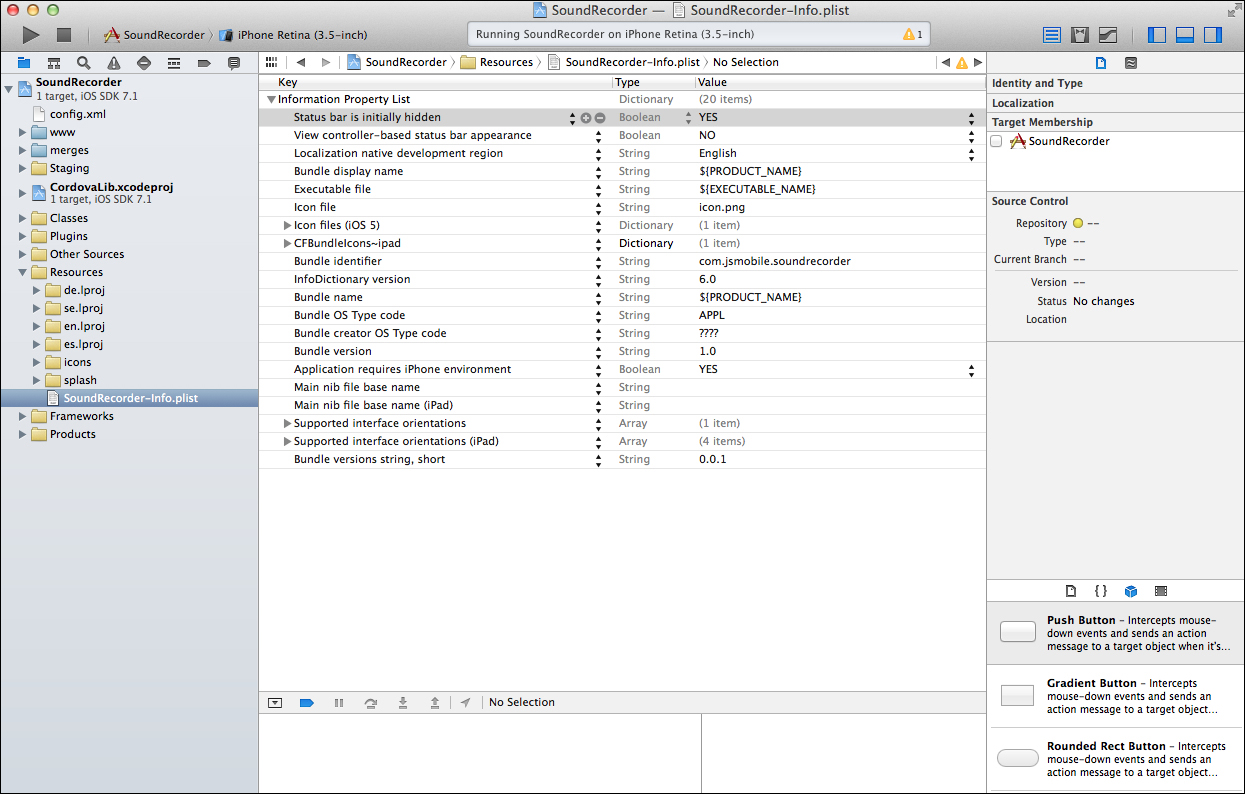
Adding properties to the SoundRecorder-info.plist file
The two properties and values are:
- The Status bar is initially hidden property set to the YES value
- The View controller-based status bar appearance property set to the NO value
After setting these two properties, click on the Build and run button again to see the fixed screen in iOS 7, as shown in the following screenshot:
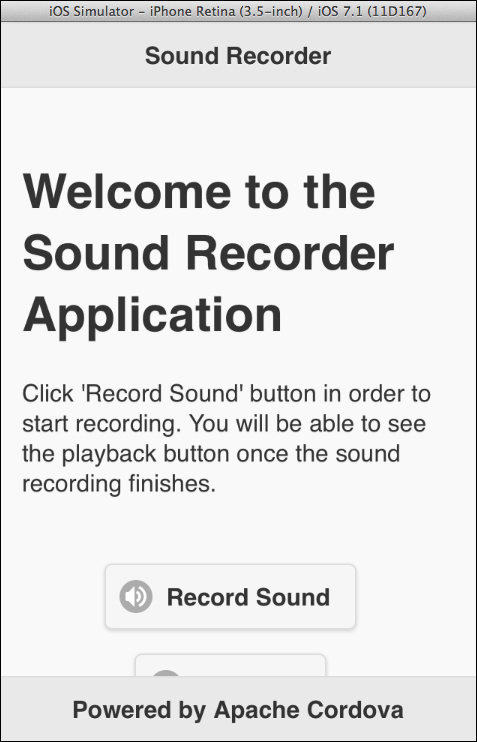
The Sound Recorder application fixed in iOS 7
In order to deploy our Sound Recorder application on a real iOS device (iPhone or iPad), you will need to follow these 20 steps carefully:
- Sign up for the iOS developer program at https://developer.apple.com/programs/ios/. There are two available enrollment types:
- Individual: Select this enrollment type if you are an individual
- Company/Organization: Select this enrollment type if you represent a company
- Generate a Certificate Signing Request (CSR) using the Keychain Access application, which you can get from the
/Applications/Utilitiesdirectory. In order to generate the certificate signing request, follow these steps:- Navigate to Keychain Access | Certificate Assistant | Request a Certificate From a Certificate Authority, as shown in the following screenshot:
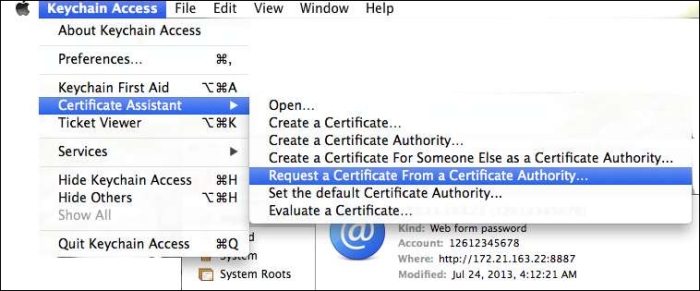
Creating a CSR using Keychain Access
- In the Certificate Assistant window, enter your e-mail address, click on the Saved to disk radio button, and check the Let me specify key pair information checkbox. Then, click on Continue.
- In the Key Pair Information window, choose 2048 bits as the key size and RSA as the algorithm. Then, click on Continue.
- Use the default filename to save the certificate request to your disk, and click on Save.
- Navigate to Keychain Access | Certificate Assistant | Request a Certificate From a Certificate Authority, as shown in the following screenshot:
- Now, we need to use the iOS member center (https://developer.apple.com/membercenter/) in order to create the application ID, register your iOS device, generate a development certificate, and create a provision profile.
- Click on the Certificates, Identifiers & Profiles link, as shown in the following screenshot. You will be introduced to the overview page, where you can click on the Identifiers link.
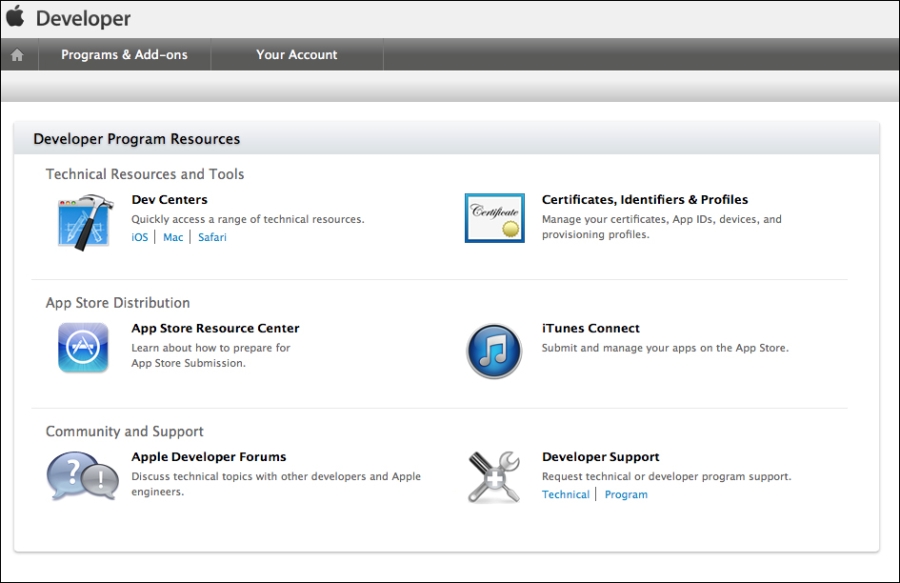
Managing certificates, identifiers, and profiles from the member center
- Select App IDs from Identifiers. Register your application ID by entering an application name and the application bundle identifier (you can get the bundle identifier from the
SoundRecorder-info.plistfile), as shown in the following screenshot. Then, click on Continue.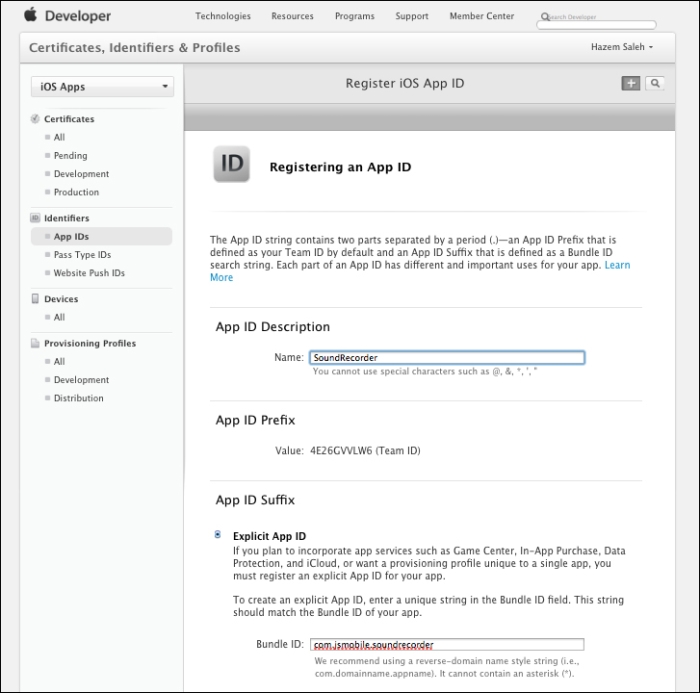
Registering your application ID
- You will be introduced to the confirmation page. Click on Submit to confirm your application ID.
- Select All from Devices. Register your iOS device by entering the device name and the device's Unique Identifier (UDID), as shown in the following screenshot. Then, click on Continue.
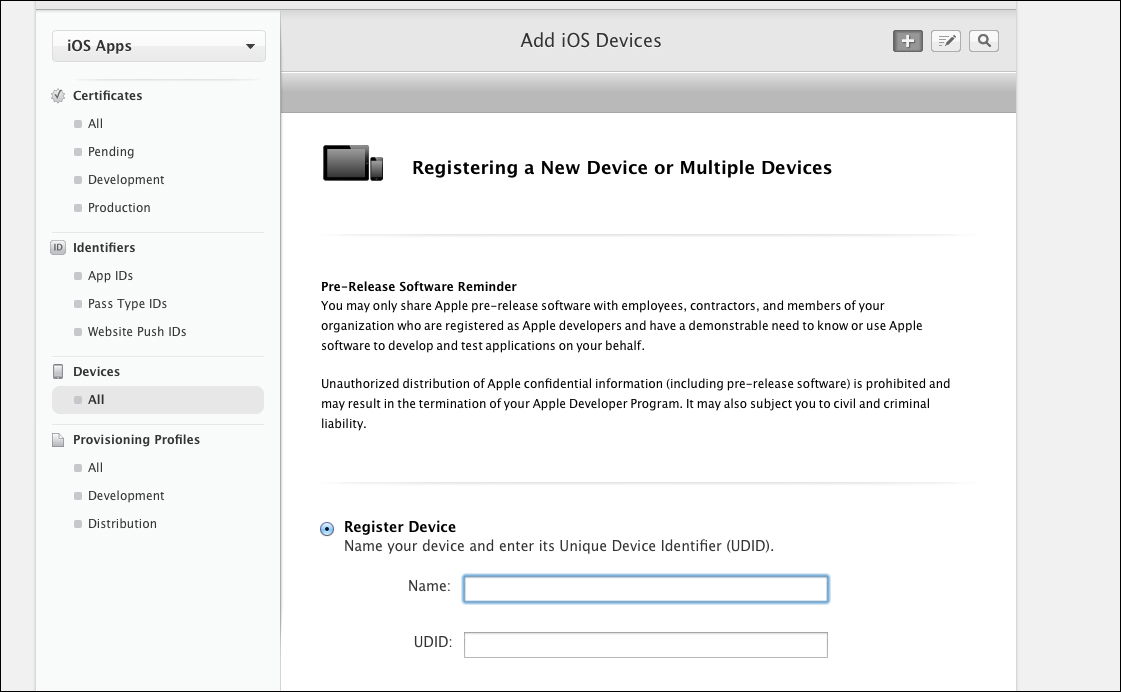
Registering your iOS device
- You will be introduced to the review page. Click on Register to register your device.
- Select Development in Certificates to create your development certificate file. Read the introduction page and click on Continue.
- In the second step of the development certificate creation process, choose the CSR file that we created in step 2 and click on the Generate button, as shown in the following screenshot:
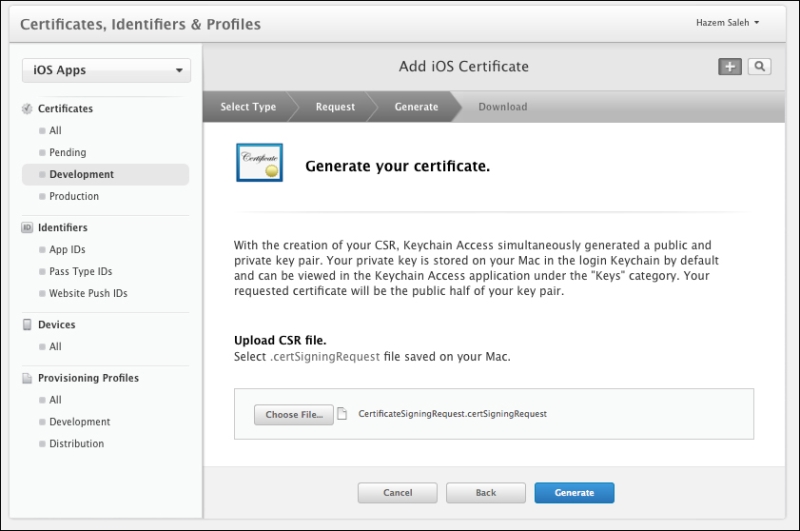
Generating your development certificate
- In the last step of the development certificate creation process, click on the Download button to download the development certificate to your machine.
- Select All from the Provision Profiles to create a provision profile, which will be installed on your iOS device. Choose the iOS App Development option from Development, as shown in the following screenshot, and then click on Continue:
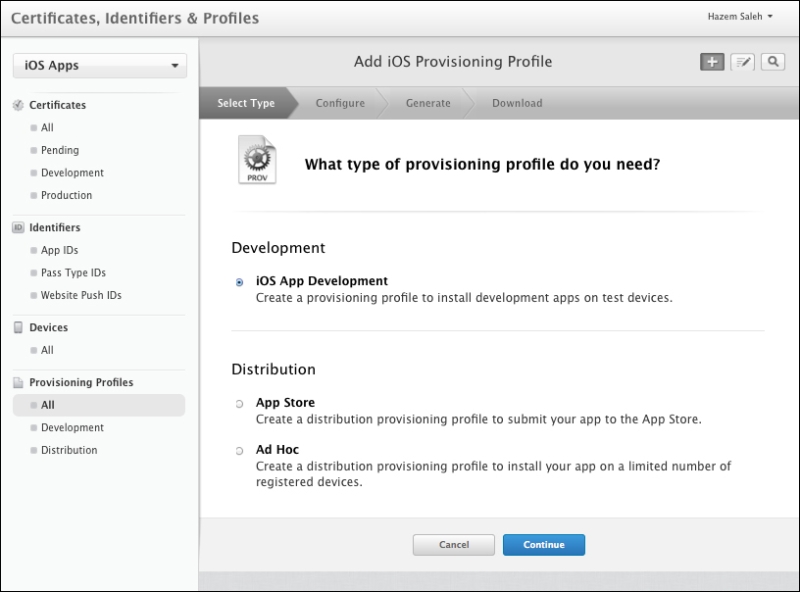
Selecting the iOS App Development provisioning profile
- In the second step of the development provisioning profile creation process, select App ID, which we created in step 5, and then click on the Continue button.
- In step 3 of the development provisioning profile creation process, select the Development certificate checkbox that we created in step 10, as shown in the following screenshot, and then click on the Continue button:

Selecting the certificate to include in the provisioning profile
- In step 4 of the development provisioning profile creation process, select your iOS device checkbox, which you registered in step 8, and then click on the Continue button.
- In step 5 of the development provisioning profile creation process, enter your preferred profile name (for example, SoundRecorderProfile) and then click on the Generate button.
- In the last step of the development provisioning profile creation process, click on the Download button to download the provisioning profile to your machine.
- Now that we have created and downloaded both the development certificate and the provisioning profile, we need to install them. Double-click on the
.cerfile that you downloaded in step 11 to install it onto a keychain on your Mac machine. If you are prompted with the Add Certificates dialog, click on OK. - In order to install the downloaded provisioning profile to your iOS device, connect your iOS device to your Mac, open the organizer application from your Xcode by selecting Organizer from Window menu, and then click on the Add button and select the
.mobileprovisionfile. You should find that this profile is a valid one, as shown in the following screenshot: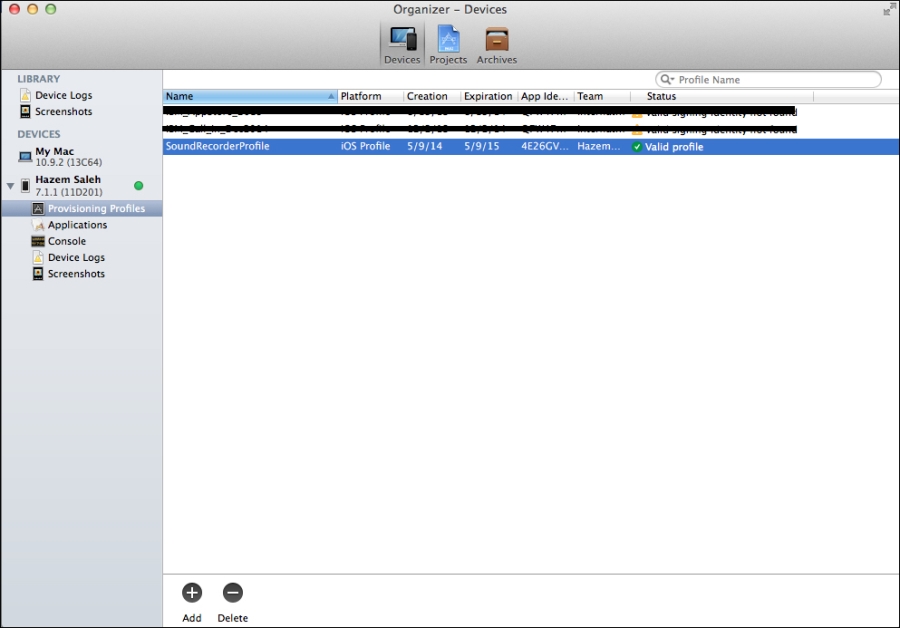
Adding a mobile provisioning profile to an iOS device
- Finally, you can deploy your application on your iOS device by selecting your iOS device from the active scheme dropdown and clicking on the Build and run button, as shown in the following screenshot. After clicking on the button, you will find our Sound Recorder application finally launched on your iOS device.
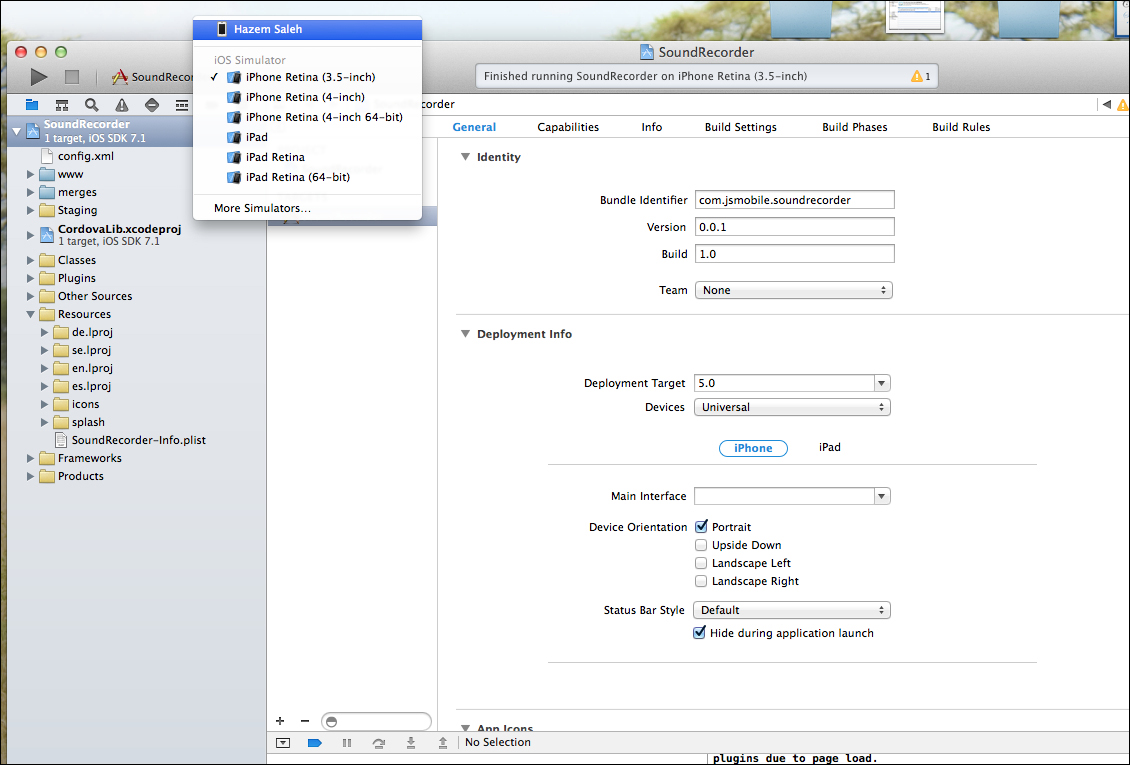
Deploying our Sound Recorder application to a real iOS device
When running your iOS application on a real device for the first time, you will receive the prompt message codesign wants to sign using key "-----" in your keychain. If you see this message, click on the Always allow button.
